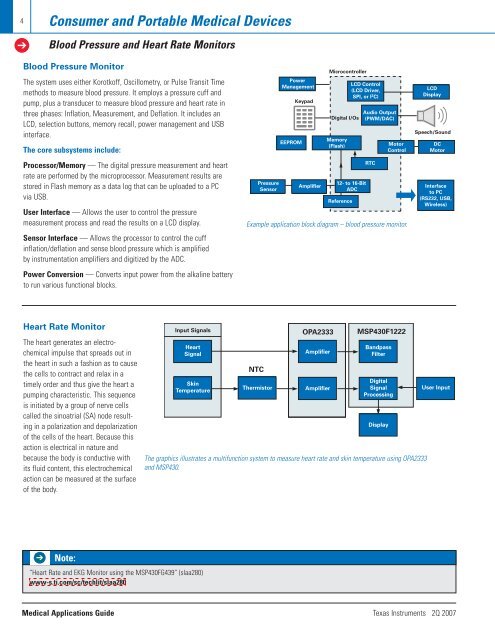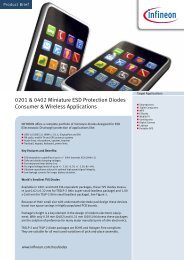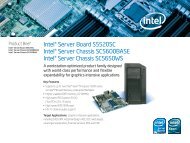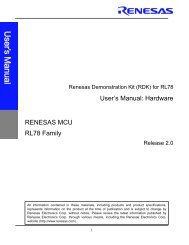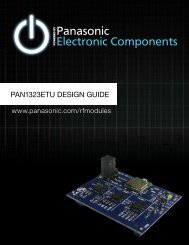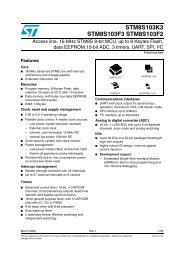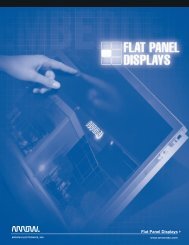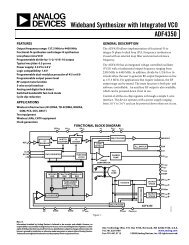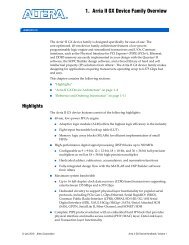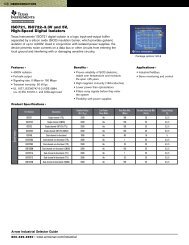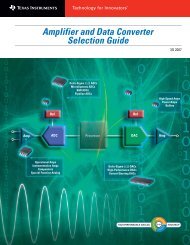Medical Applications Guide (Rev. B - Mouser Electronics
Medical Applications Guide (Rev. B - Mouser Electronics
Medical Applications Guide (Rev. B - Mouser Electronics
You also want an ePaper? Increase the reach of your titles
YUMPU automatically turns print PDFs into web optimized ePapers that Google loves.
4➔Consumer and Portable <strong>Medical</strong> DevicesBlood Pressure and Heart Rate MonitorsBlood Pressure MonitorThe system uses either Korotkoff, Oscillometry, or Pulse Transit Timemethods to measure blood pressure. It employs a pressure cuff andpump, plus a transducer to measure blood pressure and heart rate inthree phases: Inflation, Measurement, and Deflation. It includes anLCD, selection buttons, memory recall, power management and USBinterface.The core subsystems include:Processor/Memory — The digital pressure measurement and heartrate are performed by the microprocessor. Measurement results arestored in Flash memory as a data log that can be uploaded to a PCvia USB.User Interface — Allows the user to control the pressuremeasurement process and read the results on a LCD display.Sensor Interface — Allows the processor to control the cuffinflation/deflation and sense blood pressure which is amplifiedby instrumentation amplifiers and digitized by the ADC.Power Conversion — Converts input power from the alkaline batteryto run various functional blocks.PressureSensorPowerManagementEEPROMKeypadAmplifierMicrocontrollerDigital I/OsMemory(Flash)LCD Control(LCD Driver,SPI, or I 2 C)12- to 16-BitADCReferenceAudio Output(PWM/DAC)RTCMotorControlExample application block diagram – blood pressure monitor.LCDDisplaySpeech/SoundDCMotorInterfaceto PC(RS232, USB,Wireless)Heart Rate MonitorThe heart generates an electrochemicalimpulse that spreads out inthe heart in such a fashion as to causethe cells to contract and relax in atimely order and thus give the heart apumping characteristic. This sequenceis initiated by a group of nerve cellscalled the sinoatrial (SA) node resultingin a polarization and depolarizationof the cells of the heart. Because thisaction is electrical in nature andbecause the body is conductive withits fluid content, this electrochemicalaction can be measured at the surfaceof the body.Input SignalsHeartSignalSkinTemperatureNTCThermistorOPA2333AmplifierAmplifierMSP430F1222BandpassFilterDigitalSignalProcessingDisplayThe graphics illustrates a multifunction system to measure heart rate and skin temperature using OPA2333and MSP430.User Input➔Note:“Heart Rate and EKG Monitor using the MSP430FG439” (slaa280)www-s.ti.com/sc/techlit/slaa280<strong>Medical</strong> <strong>Applications</strong> <strong>Guide</strong> Texas Instruments 2Q 2007


